Physical Address
304 North Cardinal St.
Dorchester Center, MA 02124
Both striated muscle and bone are derived from the mesodermal germ layer. The limb buds form at the end of the fourth week of fetal life. Near the end of the second month of fetal life, the embryonic cartilaginous skeleton is already subdivided into its principal segments, which are the forerunners of bones of the limbs. Primary ossification centers are formed by deposition of calcium in the cartilaginous matrix after hypertrophy and vacuolization of local cartilage cells. In tubular bones, this process occurs at approximately the midpoint of the shaft and is followed by central resorption, which gives rise to the primary marrow cavity. Calcified disks proximal and distal to the primary cavity become preparatory zones of calcification after the development of the advancing, proliferating shaft during growth. Cartilage proximal and distal to the zones of calcification becomes the epiphyses. A layer of cells within the epiphyses near the shaft produces new cells interposed between the resting cartilage of the epiphysis and the older cells and calcified cartilage adjacent to the shaft. The matrix around the old cells calcifies and is invaded by capillaries and bone cells from the marrow. Bone is formed on the calcified cartilage, and new bone and cartilage undergo remodeling by osteoclasts and osteoblasts, so the length of the bone is increased ( Fig. 128.1 ). The girth of the bone and the thickness of the cortex are increased by subperiosteal accretion via activity of subperiosteal osteoblasts. Peripheral resorption of bone at the advancing ends of the shaft maintains the gentle flaring that characterizes normal tubular bone and is the mechanism responsible for what is termed modeling . Disproportionate osteoclastic activity within the shaft of the bone reams out a marrow cavity. Continued, balanced activity of all these processes permits a small tubular bone to become a large tubular bone while functional shape and relations with adjacent structures are maintained.
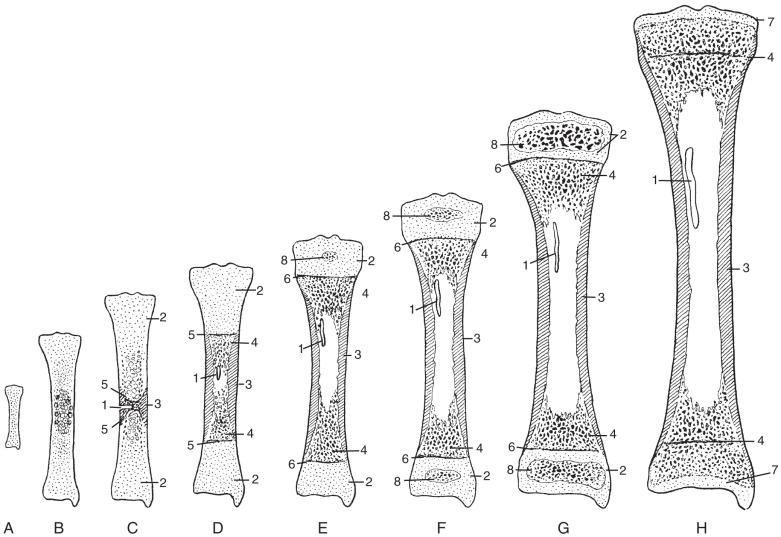
Secondary ossification centers appear in the cartilaginous epiphyses and apophyses and enlarge by similar but much slower processes than those that enlarge the shaft. Irregularities in density and discontinuities in the structure of secondary ossification centers are frequent during normal mineralization and may simulate disease. The known ages at first appearance and upon fusion of these ossification centers can serve as indicators of physical maturation ( Figs. 128.2 and 128.3 ; Table 128.1 ).
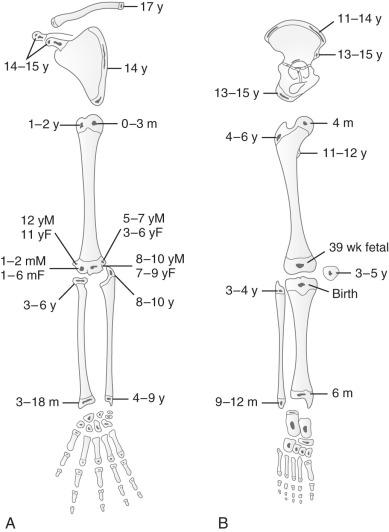
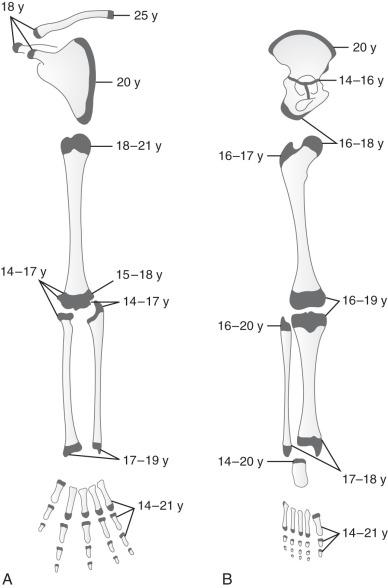
| Ossification Center | Fifth Percentile | Ninety-Fifth Percentile |
|---|---|---|
| Humeral head | 37th week | 16 postnatal weeks |
| Distal femur | 31st week | 39th week (female) |
| 40th week (male) | ||
| Proximal tibia | 34th week | 2 postnatal weeks (female) |
| 5 postnatal weeks (male) | ||
| Calcaneus | 22nd week | 25th week |
| Talus | 25th week | 31st week |
| Cuboid | 37th week | 8 postnatal weeks (female) |
| 16 postnatal weeks (male) |
The cartilaginous epiphyses are terminal remnants of the original cartilaginous models of bone. Longitudinal growth takes place at the junction of the physis and the metaphysis by proliferation of cartilage cells in the physis, calcification of the surrounding matrix, and transformation to bone through the activity of metaphyseal vessels and accompanying osteoblasts and osteoclasts. Ossification centers develop within the epiphyses; growth ceases when these secondary centers fuse, through the physis, with the metaphysis. Apophyses are outgrowths of a bone that develop where muscle tendons originate or insert. Similar to the epiphyses, the apophyses develop ossification centers that eventually fuse with the main body of the underlying bone. Apophyses are different from epiphyses in that they do not contribute to longitudinal growth. Epiphyseal and apophyseal ossification and growth occur related to matrix deposition by the spherical growth plate, which has physiology similar to the physis. When epiphyseal ossification is complete, the spherical growth plate and epiphyseal cartilage are no longer appreciable, and only articular cartilage overlies the epiphyseal bone. This process occurs simultaneously with closure of the physis at skeletal maturity.
The bones provide rigid support for the body and sites of insertion for muscles, to which the bones respond as levers. The bones are active physiologically in infants and children, changing size and shape with growth and hormone activity (related to levels of vitamin D, parathyroid hormone, calcitonin, or serum calcium and phosphate levels) and in response to mechanical stresses.
During growth, in addition to its constant increase in length and breadth, the shaft is continuously molded or reshaped to its final form in a process called modeling or tubulation . One of the most conspicuous features of modeling is progressive concentric contraction of the shaft behind the wider, advancing terminal segment ( e-Fig. 128.4 ); this process results in the flared ends of tubular bones.
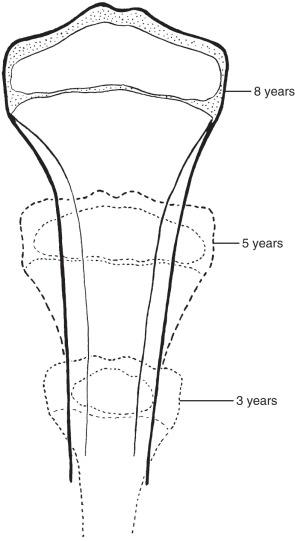
Significant disturbances in configuration of the shafts occur in many chronic diseases that affect the growing skeleton. With overtubulation, a diaphysis is abnormally narrow in caliber with accentuation of metaphyseal flaring. This usually is seen in children with cerebral palsy or other neuromuscular diseases in which normal muscular stresses are not present. With undertubulation, the diaphysis is abnormally broad in caliber with loss of the normal metaphyseal flaring; causes may include Gaucher disease, Pyle dysplasia, and osteochondromatosis.
Acute changes related to systemic disease are most commonly seen at the juxtaphyseal metaphysis, which is the most metabolically active component of the growing bone unit, and the location of primary bone deposition (e.g., metaphyseal fraying seen in persons with rickets or juxtaphyseal sclerosis with intervening areas of bony rarefaction in persons with leukemia).
Three types of bones are found in the limbs: (1) long and short tubular bones, (2) round bones in the wrists and ankles, and (3) sesamoids, which are small bones in the tendons and articular capsules. Functionally, a growing tubular bone is made up of the following segments: diaphysis, metaphysis, physis, and epiphysis ( Fig. 128.5 ). “Long bones” have epiphyses at both ends. Short tubular bones (“short bones”) have epiphyses at one end. In the hands and feet, secondary ossification centers appear in the bases of the phalanges and in the distal ends of the second through fifth metacarpals and metatarsals. Epiphyses for the first metacarpal and first metatarsal are found in the proximal ends of the bones. The location of the secondary centers appears to be related to the sites of maximal joint motion of individual short tubular bones. Apparent epiphyseal ossification centers observed at the ends of short bones, where their occurrence is not expected, are termed pseudoepiphyses .
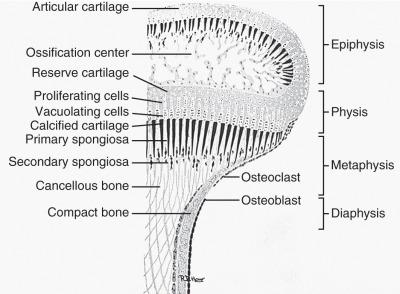
The gestational age of a newborn can be estimated radiographically through several methods. The proximal humeral ossification center appears shortly after birth, with a 95% confidence interval between 37 weeks' gestation and 16 weeks' postnatal life. Ossification before 37 weeks is unusual; therefore the presence of the proximal humeral ossification center is an indication that a newborn is at term or near term. Teeth appear at a characteristic time; the first deciduous molars form at 33 weeks, and the second deciduous molars form at 36 weeks. The range of values is great for the radiographic appearance of various appendicular bone epiphyseal ossification centers, even in premature infants ( Table 128.1 ).
Evaluation of bone age is used to estimate biologic maturation relative to chronologic age. Differences in familial, racial, and socioeconomic factors limit the applicability of the standards of Greulich and Pyle (which were developed in the 1940s) to today's children. It is well accepted that maturation varies between races. For instance, African American children mature faster than do white children. The hand, with its numerous secondary centers in phalanges and metacarpals, and to a lesser degree the wrist, are used as an index of total skeletal maturation. Standard deviations, which are based on chronologic age, are somewhat broad. A bone age within the 5% to 95% confidence interval (or ±2 standard deviations) is considered normal.
In children younger than 2 years, use of the standards of Greulich and Pyle is limited because relatively little change is noted in the ossification centers of the hand and wrist during this period. More rapid changes may be observed in the knee or foot, however. Radiographs of the left knee or left foot—anteroposterior and lateral—can be obtained in children younger than 2 years of age and compared with published standards.
The Risser classification can be used to assess skeletal maturation through evaluation of the appearance and state of fusion of the iliac crest. Ossification of the iliac crest begins laterally and proceeds medially: stage 0—no ossification; stage I—up to 25% ossified; stage II—25% to 50% ossified; stage III—50% to 75% ossified; stage IV—75% to 100% ossified; and stage V—fully ossified and fused ( e-Fig. 128.6 and Fig. 134.2 ).
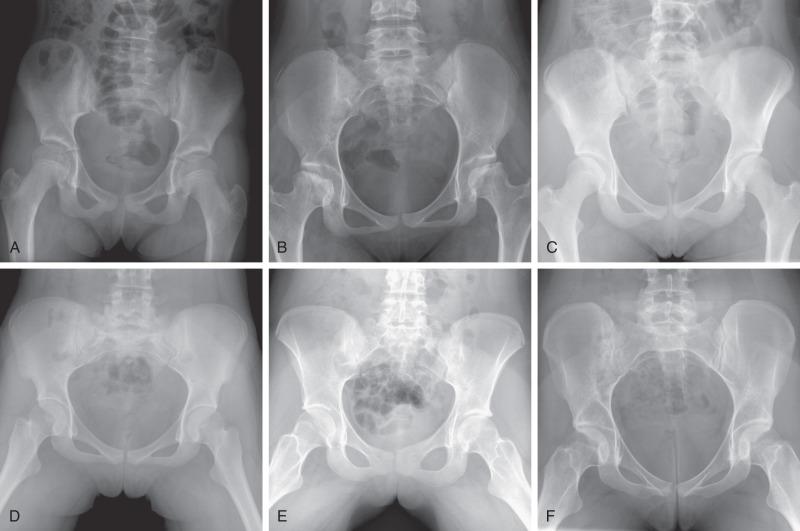
Assessment of skeletal age by radiography is useful in many clinical scenarios. Boxes 128.1 and 128.2 list causes of advanced and delayed skeletal maturation, respectively. Menarche typically occurs after fusion of the physes of the distal phalanges. Bone age can be used with long bone measurements to predict adult height. Assessment of bone age is also valuable in the planning of orthopedic treatments, including epiphysiodesis, leg-lengthening procedures, and scoliosis management.
Acrodysostosis
Adrenogenital syndrome (adrenocortical tumor or hyperplasia)
Cerebral gigantism
Gonadal tumors (androgen or estrogen secreting)
Growth hormone excess (gigantism)
Hyperthyroidism (maternal or acquired)
Hypothalamic tumors
Idiopathic familial advanced bone age
Idiopathic isosexual precocious puberty
Lipodystrophy
Liver tumors (choriocarcinoma, hepatoma)
McCune-Albright syndrome (polyostotic fibrous dysplasia)
Medication with sex hormones
Pinealoma
Premature adrenarche
Premature thelarche
Pseudohypoparathyroidism
Various syndromes
Addison disease
Chromosomal disorders (e.g., trisomy 21 and trisomy 18)
Chronic illness
Chronic renal disease
Chronic severe anemia (e.g., sickle cell anemia and thalassemia)
Congenital heart disease (especially cyanotic)
Congenital malformation syndromes
Constitutional delay
Cushing syndrome
Growth hormone deficiency
Hypogonadism (e.g., Turner syndrome)
Hypothyroidism
Idiopathic causes
Inflammatory bowel disease
Intrauterine growth retardation
Juvenile diabetes mellitus
Malabsorption syndromes (e.g., celiac disease)
Malnutrition
Neurologic disorders
Panhypopituitarism
Rickets
Skeletal dysplasias (most)
Steroid therapy
Experience and knowledge often are the best resources for successfully identifying normal variants. Compendiums of normal variants (e.g., An Atlas of Normal Roentgen Variants That May Simulate Disease by Keats and Anderson and Borderlands of Normal and Early Pathological Findings in Skeletal Radiography by Freyschmidt et al. ) are invaluable resources.
Many epiphyseal and apophyseal ossification centers are irregular and fragmented in their early development ( Fig. 128.7 ). When evaluating the significance of irregular ossification in a single area, it is important to remember that normal irregularities of ossification usually are symmetric and accompanied by similar changes in other areas of the skeleton. Normal epiphyseal and apophyseal fragmentary ossification tends to have a smooth, round, and sclerotic appearance. Sometimes epiphyseal fragmentary ossification centers may have a jigsaw configuration. Normal epiphyseal fragmentary ossification should be differentiated from acute fractures that tend to have a linear contour with nonsclerotic margins with accompanying soft tissue swelling and joint effusions.
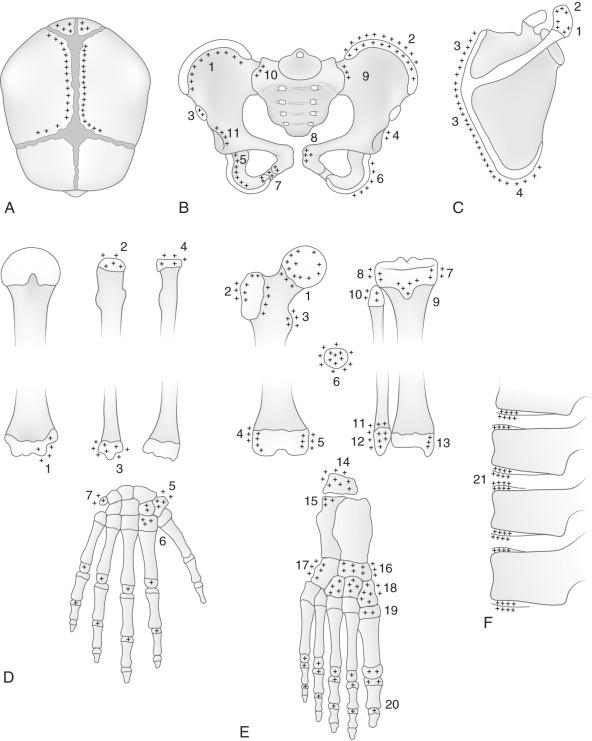
Physiologic osteosclerosis of the newborn is a common finding. The long tubular bones of fetuses, premature infants, and term newborn infants often appear sclerotic compared with the bones of older children because of proportionately thicker cortical bone and more abundant spongiosa during fetal and neonatal life ( e-Fig. 128.8 ). The sclerotic features disappear gradually during the first weeks of life and resolve by 2 to 3 months of age.
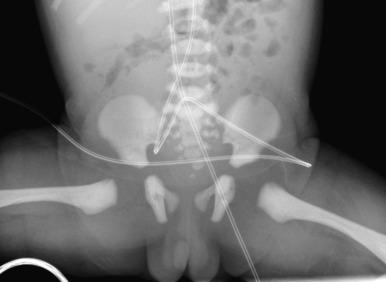
Physiologic periosteal reaction in the newborn also is a common finding seen in infants from 1 to 4 months of age and in both premature and term infants. Physiologic periosteal new bone is diaphyseal, smooth, regular, and 2 mm or less in thickness ( Fig. 128.9 ). Physiologic periosteal new bone is most common in the tibia, femur, and humeral diaphysis and occasionally is seen in the radius and ulna. In most infants, physiologic periosteal new bone is symmetric; however, it may be asymmetric in one-third to one-half of patients. Traumatic periosteal new bone tends to be asymmetric, metaphyseal, thicker, and irregular compared with physiologic periosteal new bone.
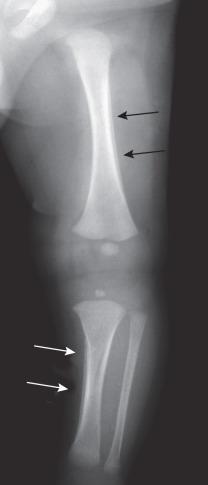
A variety of normal variants in the metaphyses of infants may simulate injury. It is important to distinguish these findings from the classic metaphyseal lesions of child abuse (see Chapter 143 ). The most common variant is the subperiosteal bone collar of the juxtaphyseal metaphysis, which has a normal step-off that may mimic a metaphyseal lesion of child abuse ( Fig. 128.10 ).
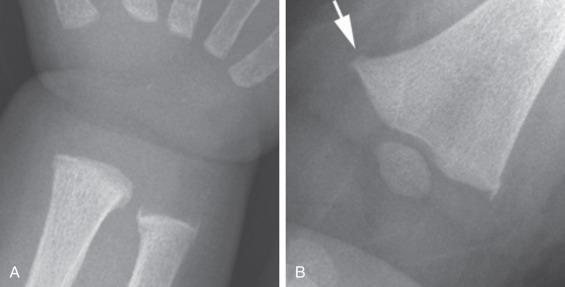
Gas (nitrogen) is commonly seen in joints of young children as a result of traction needed to appropriately position the child. Some authors hold that the presence of this vacuum phenomenon within the joint on radiography excludes a joint effusion.
The following selected, important variants should not be confused with pathology.
Sclerotic epiphyseal ossification centers of the phalanges are called ivory epiphyses ( e-Fig. 128.11 ). They occur in approximately 1 in every 300 patients. Ivory epiphyses usually are found in the distal phalanges and in the middle phalanx of the fifth digit. Maturation may be retarded. Ivory epiphyses are usually sporadic and occur in developmentally normal children but may occur in association with cone-shaped epiphyses in dysplastic syndromes such as Cockayne's syndrome, trichorhinophalangeal syndrome, and multiple epiphyseal dysplasia. Ivory epiphyses are more frequently found in the toes compared with the fingers.
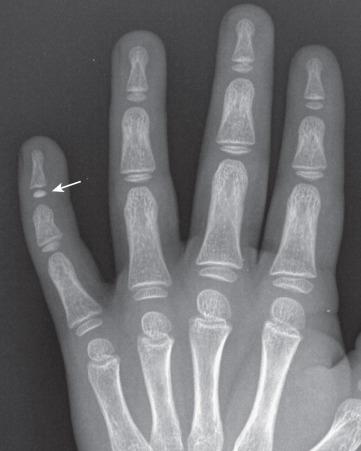
Cone-shaped epiphyses of the phalanges ( e-Fig. 128.12 ) occur singly or in combination and most commonly affect the terminal phalanges. When they occur in isolation, they may be related to trauma with resultant central physeal growth disturbance. When they are multiple, they may be seen in association with dysplastic syndromes such as trichorhinophalangeal syndrome and cartilage hair hypoplasia. Cone-shaped epiphyses are found more frequently in the toes than in the fingers ( Fig. 128.13 ).
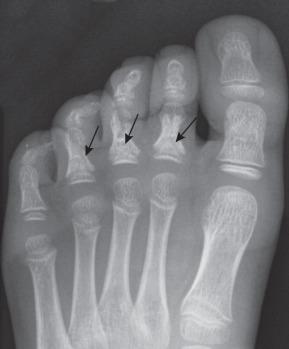
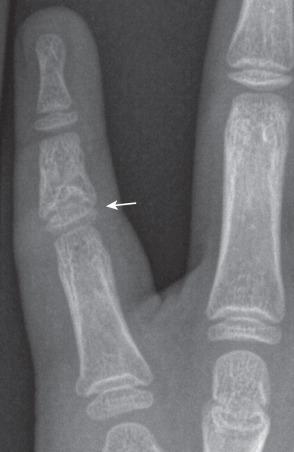
During puberty, a longitudinally oriented, scalelike secondary ossification center appears within the proximal apophyseal cartilage of the fifth metatarsal ( Fig. 128.14 ). Irregular ossification of the apophysis is common. The normal apophyseal ossification center may appear widely spaced from the underlying fifth metatarsal, simulating fracture. The fifth metatarsal apophysis also may be bifid ( e-Fig. 128.15 ). This presentation should be differentiated from a fifth metatarsal avulsion fracture related to the peroneus brevis insertion, which has a horizontal orientation ( e-Fig. 128.16 ) (see also Chapter 142 ).
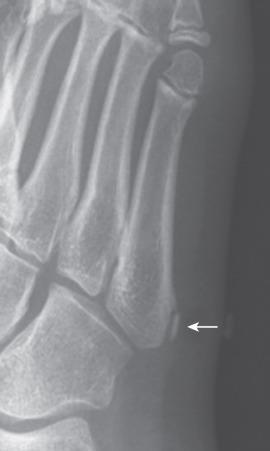
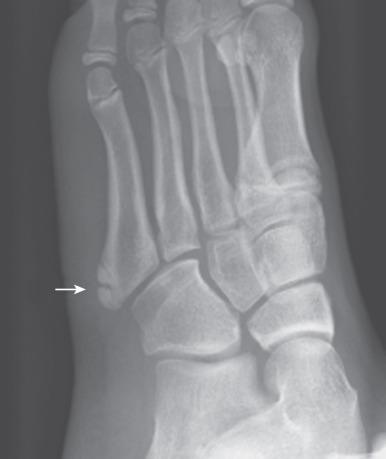
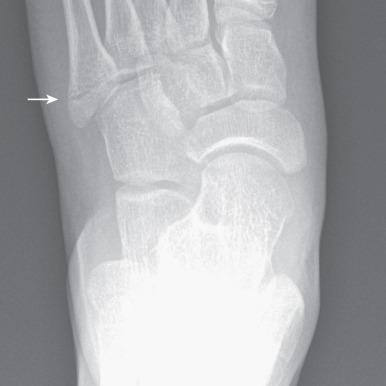
Pseudoepiphyseal ossification centers may appear in the proximal cartilaginous portion of the growing second through fifth metacarpals and metatarsals and in the distal cartilage of the first metacarpals and metatarsals ( Fig. 128.17 and e-Fig. 128.18 ). They are formed from a thin rod of osteogenic tissue that invades the proximal or distal cartilage from the shaft. The end of the rod enlarges to form a mushroom-shaped mass of bone that appears radiographically as the “pseudoepiphysis.” The site of fusion of the pseudoepiphysis with the shaft often is indicated by a notch. Pseudoepiphyses are well formed by 4 to 5 years of age and fuse with the underlying shaft at the time of skeletal maturation. Sporadic pseudoepiphysis most commonly affects the second metacarpal bone of the hand, occurring in approximately 15% of children. Pseudoepiphyses may be seen with higher frequency in children with hypothyroidism, Down syndrome, and cleidocranial dysplasia.
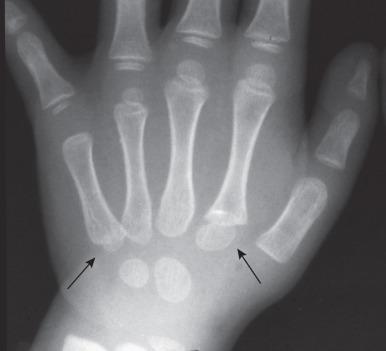
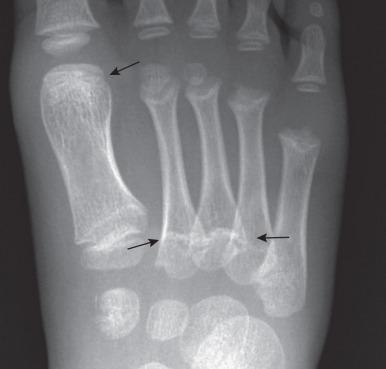
Sesamoid bones are present in the foot and hand. Sesamoids of the great toe reside within the medial and lateral slips of the flexor hallucis brevis tendon overlying the head of the first metatarsal. The medial great toe sesamoid is bipartite in 4% to 33% of patients ( e-Fig. 128.19 ). Sesamoids of the feet may develop a stress reaction or a complete fracture and may be difficult to distinguish from a bipartite sesamoid on radiographs; magnetic resonance imaging (MRI) may be useful in distinguishing a normal bipartite sesamoid and underlying stress injury. For the first metatarsal phalangeal, stress injury tends to affect the medial sesamoid more frequently than the lateral sesamoid. In addition to the sesamoids, numerous other supernumerary ossicles of the foot and ankle exist ( Fig. 128.20 ).
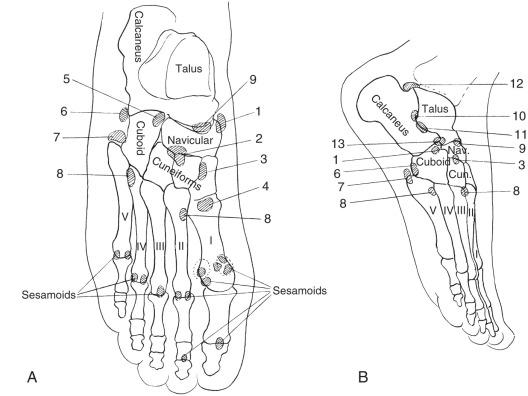
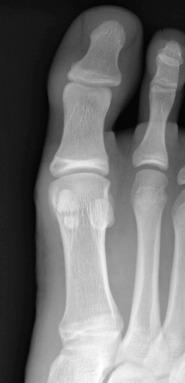
Irregular mineralization often occurs in the developing carpal bones ( e-Fig. 128.21 ). The pisiform is the bone most frequently affected ( e-Fig. 128.22 ). In addition, carpal bones sometimes may have wavy cortical contours most commonly affecting the capitate, which should not be confused with erosions.
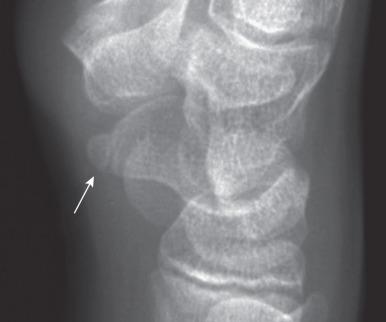
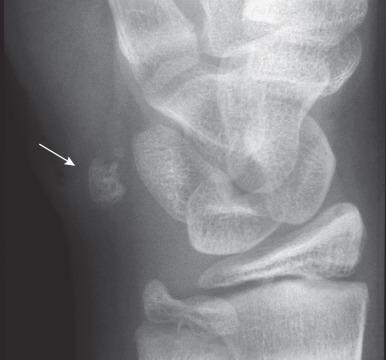
The os styloideum is a bony protrusion at the dorsum of the wrist between the trapezoid, capitate, and second and third metacarpals. It may be isolated and mobile or fused to an adjacent bone. The os styloideum is present in 1% to 3% of patients and presents as a palpable mass ( Fig. 128.23 ). The differential diagnosis for a dorsal palpable abnormality along the wrist is an os styloideum versus a ganglion.
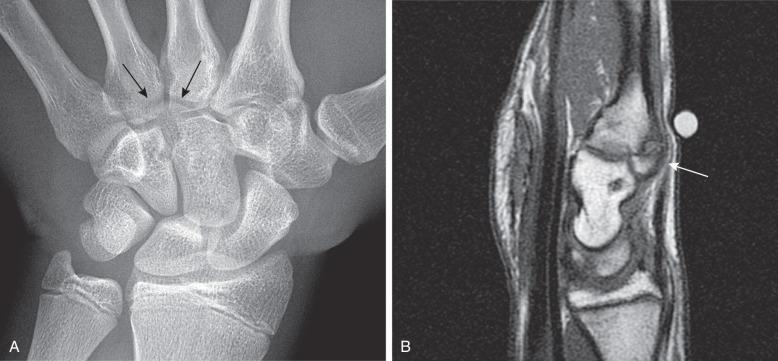
Separate ossification centers may appear in the regions of the ulnar ( e-Fig. 128.24 ) and radial ( Fig. 128.25 ) styloid processes before uniting with the main ossification center. The ulnar accessory ossification center should not be confused with ulnar styloid fracture nonunions.
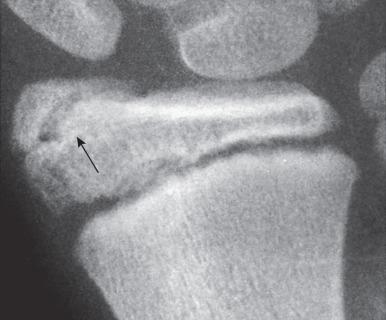
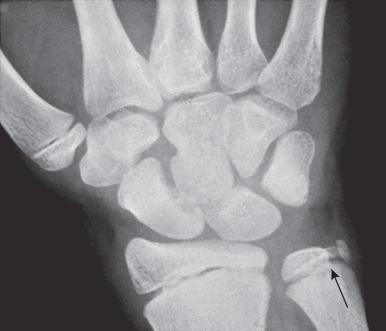
Accessory ossification centers may occur in the epiphyses of phalanges and metatarsal bones. Bifid epiphysis is most common in the great toes, where examination before fusion of the centers is complete may simulate fracture ( e-Fig. 128.26 ). The affected epiphysis is relatively sclerotic.
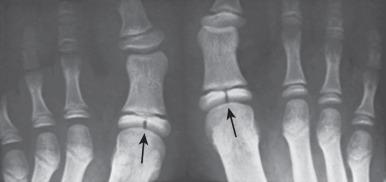
The phalanges, especially the middle group, frequently lack epiphyseal centers in healthy children; this absence may be associated with symphalangism at the affected joints. Forty percent of the population have a biphalangeal ( e-Fig. 128.27 ) fifth toe that may predispose to hammer or claw toe deformities.
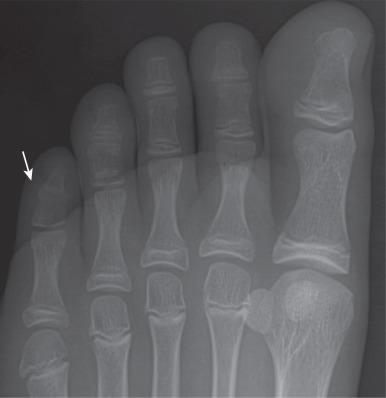
The ossification center for the calcaneus is present at birth. Occasionally the body of the calcaneus may ossify from two or more independent centers ( Fig. 128.28 ). This finding is rare as a normal variant. More often it is associated with an underlying disorder such as Down syndrome, mucolipidosis, or Larsen syndrome.
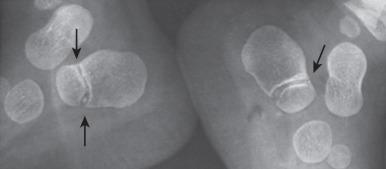
Become a Clinical Tree membership for Full access and enjoy Unlimited articles
If you are a member. Log in here